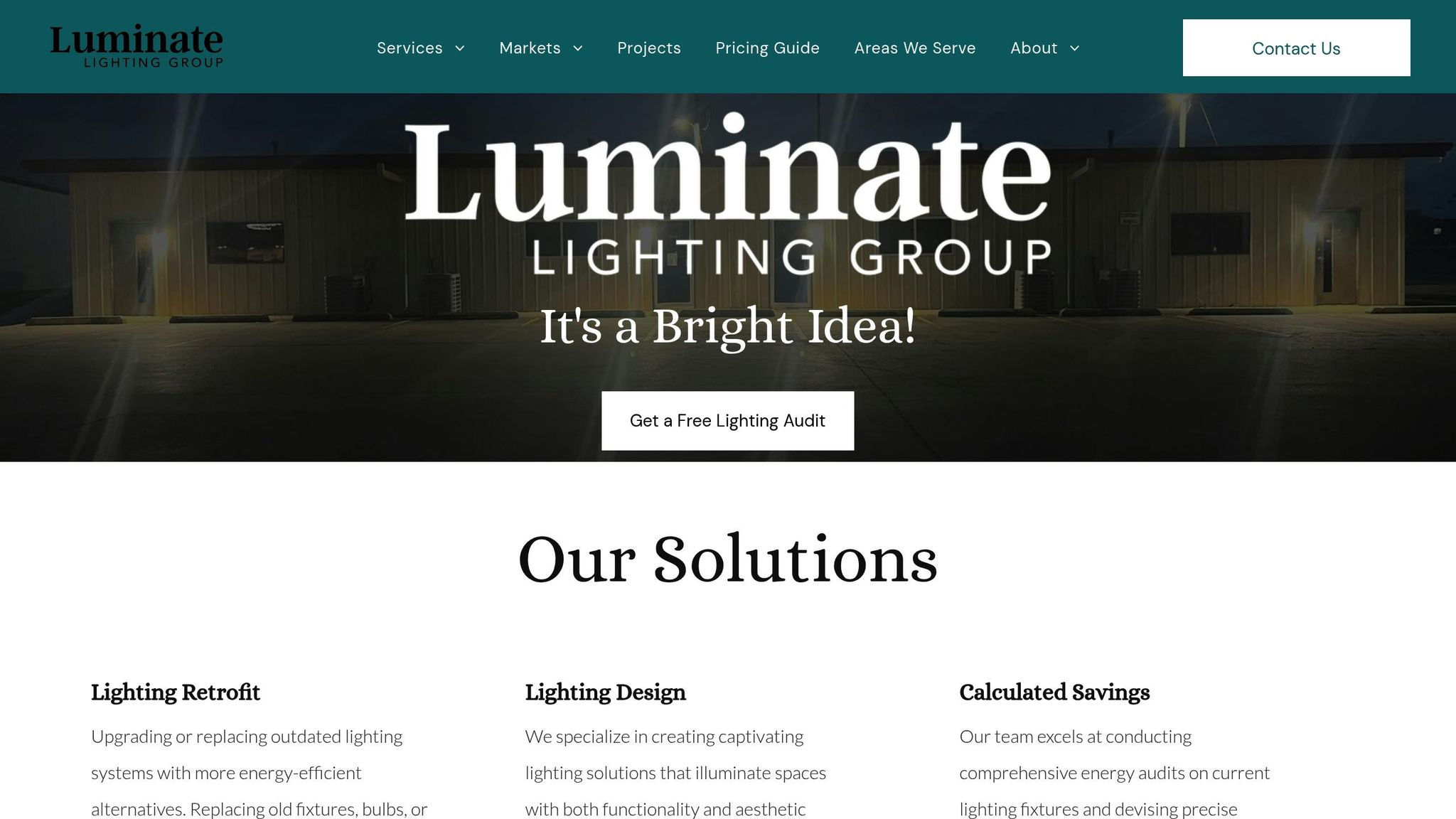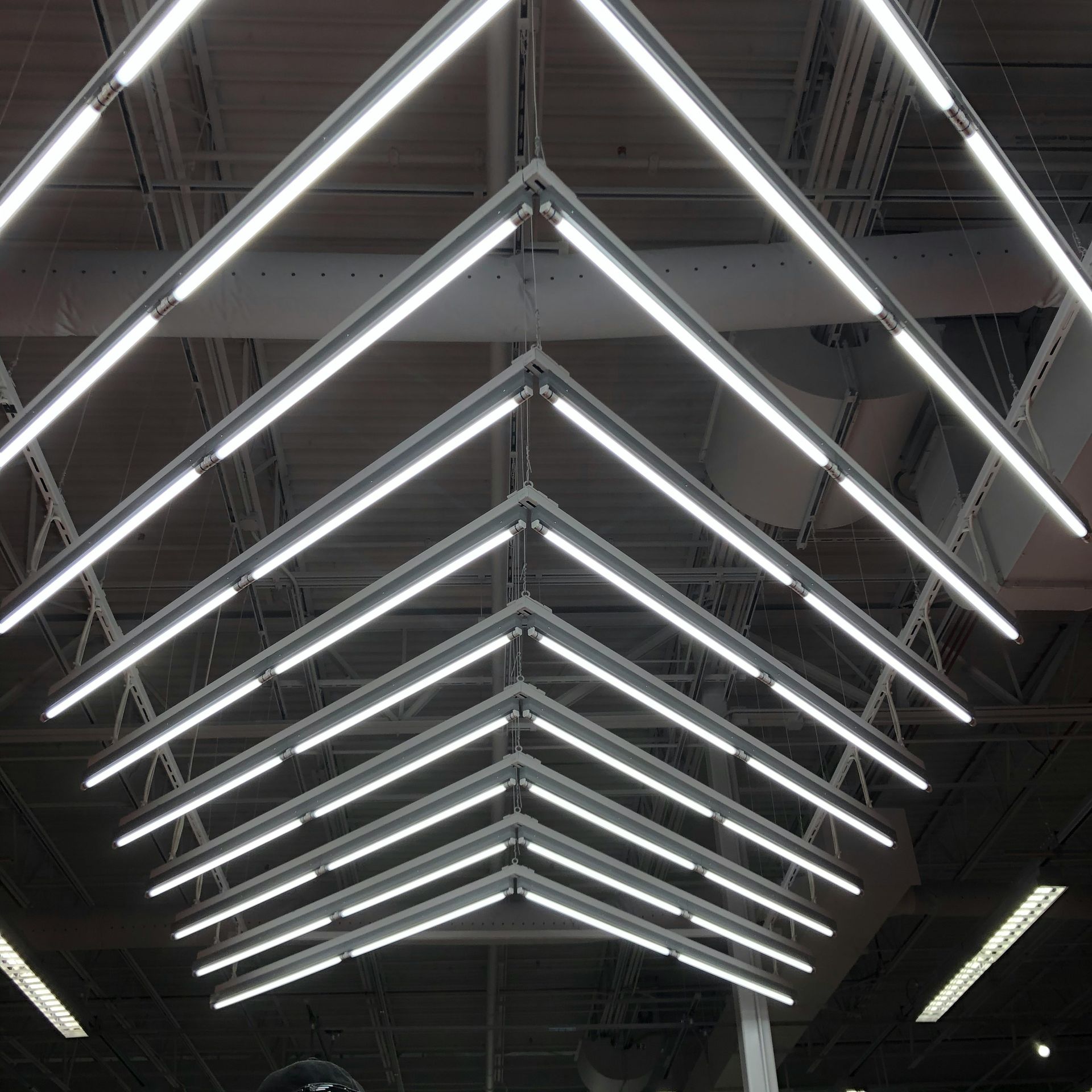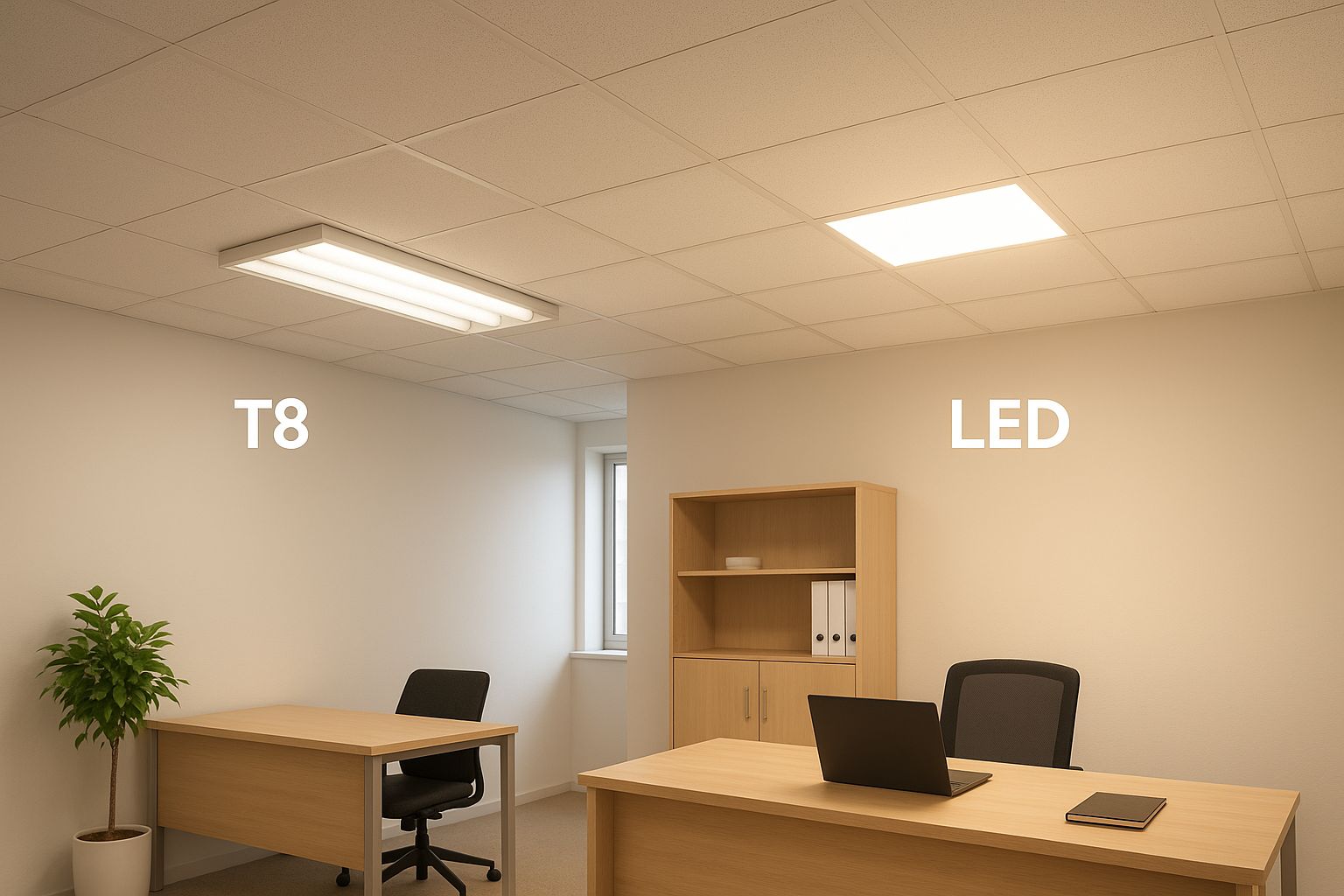Ultimate Guide to LED Color Temperatures for Commercial Lighting
Ultimate Guide to LED Color Temperatures for Commercial Lighting
LED color temperature, measured in Kelvin (K), determines whether light appears warm (yellowish) or cool (bluish-white). This choice impacts the mood, functionality, and productivity of a space. Here's what you need to know:
- Warm White (2,700K–3,000K): Creates a cozy, inviting atmosphere. Ideal for restaurants, hotels, and luxury retail.
- Neutral White (3,100K–4,500K): Mimics natural daylight, balancing comfort and focus. Perfect for offices, classrooms, and meeting rooms.
- Daylight White (4,600K–6,500K): Bright and crisp, suited for tasks requiring precision, such as in hospitals, kitchens, and warehouses.
Choosing the right color temperature depends on the purpose of your space. For example:
- Offices benefit from neutral tones to boost focus.
- Hospitality spaces use warm tones for relaxation.
- Industrial areas prefer daylight tones for visibility and safety.
Emerging trends like tunable white lighting and human-centric lighting align with natural daylight patterns, improving well-being and productivity. Energy-efficient retrofits with smart controls further optimize costs and functionality.
Selecting the right LED lighting requires balancing aesthetics, functionality, and compliance with regulations. Partnering with experts can simplify this process, ensuring your space achieves its lighting goals effectively.
Understanding & choosing colour temperature in LED lights
LED Color Temperature Ranges and Where to Use Them
Choosing the right color temperature can make all the difference in setting the mood and meeting the functional needs of a commercial space. By understanding the Kelvin scale and its applications, you can align your lighting choices with both practical requirements and aesthetic goals. Let’s break down the three main color temperature ranges and their ideal uses.
2000K–3000K: Warm White
Warm white lighting is known for its inviting and cozy feel. It enhances warm-toned colors like reds, yellows, and oranges, while softening cooler tones such as greens and blues.
This range is commonly used in high-end restaurants, luxury retail spaces, and hotels, where creating a relaxed and welcoming ambiance is key. For quick-serve restaurants, a range of 2,700K to 3,500K is often preferred, while luxury retail spaces might extend up to 4,000K to highlight merchandise and create an upscale atmosphere.
3100K–4500K: Neutral White
Neutral white lighting strikes a balance that mimics natural daylight, offering excellent color accuracy .
In office settings, a range of 3,000K to 4,000K supports focus and productivity without feeling overly harsh. Educational facilities, such as classrooms, often benefit from slightly cooler tones, ranging from 3,500K to 5,000K, to encourage concentration and learning. Research suggests that around 4,000K is ideal for spaces like meeting rooms and workshops, providing a productive yet comfortable environment. Neutral white lighting is also a practical choice for restrooms and hotel bathrooms, where clarity is important.
4600K–6500K: Daylight White
Daylight white lighting offers bright, crisp illumination that’s perfect for tasks requiring precision and attention to detail .
Healthcare facilities often rely on this range, with hospitals using cooler tones between 3,500K and 5,000K, while surgical areas benefit from even brighter lighting for maximum visibility. Industrial and manufacturing spaces also favor daylight white, with guidelines recommending 4,000K to 5,000K for optimal clarity and safety. In commercial kitchens, cooler temperatures in this range help staff stay alert and distinguish ingredients more easily.
Settings like garages, workshops, and laboratories thrive under lighting around 5,000K, which enhances visibility and precision. Daylight white is also a go-to choice for security lighting and parking garages, where ranges between 3,000K and 5,000K are typically recommended for safety and clear visibility.
| Color Temperature Range | Best Commercial Applications | Key Benefits |
|---|---|---|
| 2000K–3000K (Warm White) | Restaurants, hotels, luxury retail, coffee shops | Creates a welcoming ambiance, enhances warm tones, promotes relaxation |
| 3100K–4500K (Neutral White) | Offices, classrooms, meeting rooms, general retail | Provides balanced lighting, accurate color rendering, and reduces eye strain |
| 4600K–6500K (Daylight White) | Hospitals, kitchens, warehouses, laboratories | Enhances alertness, supports detail-oriented tasks, and improves visibility |
How to Choose the Right LED Color Temperature
Picking the right LED color temperature means balancing functionality, comfort, energy efficiency, and compliance with regulations. Factors like the type of space, visual comfort, and energy/code requirements all play a role in making the best choice.
Space Type and Function
The purpose of your commercial space heavily influences the choice of color temperature. It impacts everything from mood and productivity to visual clarity. Lighting designer Scott Abbott puts it this way:
"Think of color temperature as the expression of your business's personality".
Instead of focusing on specific temperature ranges, think about how the function of your space drives the lighting needs. For instance:
- Offices need lighting that boosts focus without causing eye strain during long workdays.
- Industrial settings require bright lighting for safety and precision during extended shifts.
- Healthcare facilities depend on accurate color rendering for medical tasks and patient care.
- Retail spaces should match the desired shopping experience. Relaxed lighting works for boutiques, while brighter lighting enhances product visibility in larger stores. In fact, effective retail lighting can increase sales by up to 40%. An ENERGY STAR study even reported a 19% sales boost when switching to LED lighting.
- Hospitality venues focus on creating cozy environments that encourage guests to relax and stay longer.
Here’s a quick breakdown:
| Space Type | Primary Lighting Needs | Key Benefits |
|---|---|---|
| Office Spaces | Focus, reduced eye strain | Higher productivity |
| Industrial/Manufacturing | Safety, visibility | Fewer accidents, better accuracy |
| Retail | Shopping experience alignment | Better sales, improved product display |
| Healthcare | Accurate color rendering | Precision in medical tasks |
| Hospitality | Relaxing atmosphere | Guest comfort and longer visits |
Choosing lighting that aligns with your space’s function also enhances visual comfort and productivity.
Visual Comfort and Worker Productivity
Lighting plays a big role in productivity and comfort. Studies show that white lighting can boost productivity by up to 15%, while yellow lighting reduces eye fatigue by 20%. Cool white lighting is particularly effective for detailed tasks, improving performance by 10–20% in environments like laboratories or design studios. However, too much blue light exposure can disrupt melatonin levels and lead to eye strain.
On the other hand, warm lighting is great for reducing stress, lowering it by 15%, and promoting relaxation, increasing it by 30%. This makes it ideal for areas like break rooms and lounges. Neutral lighting around 4,000K strikes a balance, enhancing alertness by about 20% without affecting sleep, making it a good fit for standard office hours.
Visual comfort isn’t just about color temperature - it also depends on factors like light intensity, distribution, and quality. Using layered lighting that combines ambient, task, and accent lighting can create a balanced and comfortable environment.
While comfort and productivity are key, energy efficiency and compliance with regulations are just as important.
Energy Efficiency and Code Requirements
Energy efficiency standards have become stricter in recent years, with modern building codes demanding 45% more efficiency than a decade ago. LEDs are a perfect fit for these standards, using 75% less energy and lasting up to 25 times longer than traditional incandescent bulbs .
In some areas, regulations also limit color temperatures. For example, outdoor lighting in some cities is capped at 3,000K to minimize light pollution. Building codes may also specify minimum illumination levels for different types of spaces. It’s always a good idea to consult local authorities or experts to ensure your lighting setup meets all requirements.
When designing your lighting plan, think about the specific needs of each area. High-traffic zones might need different lighting than storage spaces. The ultimate goal is to create a lighting system that complies with regulations, supports your business objectives, and promotes employee well-being.
sbb-itb-86fe545
Current Trends in Commercial LED Color Temperature
As businesses increasingly prioritize efficiency and employee well-being, commercial LED lighting is evolving to meet these demands. The focus has shifted from static color temperatures to adaptive systems that cater to human needs and dynamic work environments.
Tunable White Lighting Systems
Tunable white lighting represents a significant leap forward in LED technology. Unlike traditional systems with fixed color temperatures, these solutions allow users to adjust the light's color temperature throughout the day. This flexibility not only creates more tailored environments but also improves energy efficiency and lighting performance [17].
The benefits of tunable lighting are backed by real-world data. For instance, a 2016 CBRE Netherlands study found that Kelvin-adjustable lighting increased productivity by 18%, improved accuracy by 12%, boosted employee satisfaction by 76%, and left 71% of employees feeling more energized.
The technology is also becoming more accessible. Wireless platforms, such as those using Wi-Fi, are replacing older hardwired systems, reducing costs for labor and materials. These wireless systems are particularly advantageous for retrofitting projects, as they don't require altering existing wiring and are easier to relocate. Manufacturers are even incorporating RGB LEDs into tunable systems, enhancing the quality and versatility of lighting.
Lighting expert Lynne Stambouly highlights the practical benefits of tunable white lighting:
"Tunable white is something we can control effectively. It lets us shift the color temperature of light throughout the day in a way that's visually and emotionally supportive".
This focus on adaptability is complemented by human-centric lighting, which takes a more biological approach to lighting design.
Human-Centric Lighting
Human-centric lighting (HCL) builds on adaptive systems by aligning light intensity and color temperature with natural daylight patterns. This approach supports the body's circadian rhythm, affecting not just visibility but also sleep, focus, and overall well-being. Research shows that well-lit environments can enhance focus by 15% and reduce errors by up to 20%. Additionally, studies have found a 12% improvement in task performance when employees work under circadian lighting. These benefits are particularly relevant given that 68% of employees report dissatisfaction with their office lighting.
The advantages extend beyond offices. Employees in workplaces with windows receive 173% more white light during the day and sleep an additional 46 minutes per night. A 2013 study also linked human-centric tunable lighting to better sleep and reduced stress and depression levels. In schools, students exposed to more natural light achieved 26% higher reading scores and 20% higher math scores compared to peers in dimly lit classrooms. Tunable white lighting has even been used in nursing homes to ease dementia symptoms and in psychiatric hospitals to reduce aggression.
Action Services Group underscores the broader impact of HCL:
"Businesses seek new ways to improve employee well-being and happiness at work. Human-centric lighting is one major strategy that has improved productivity, mood, and health".
The integration of artificial intelligence is pushing these systems even further. AI can customize lighting to individual preferences, while IoT-enabled smart lighting connects seamlessly with other building systems, creating truly responsive environments.
Energy-Efficient Retrofits and Custom Design
The push for sustainability is driving a surge in LED retrofitting and custom lighting solutions. Lighting can account for up to 30% of a building's energy use, making efficient systems essential for reducing costs and meeting environmental goals. Modern LEDs deliver up to 110 lumens per watt, significantly outperforming traditional bulbs. These systems also lower maintenance costs while improving overall energy efficiency.
Real-world examples highlight the financial and operational benefits of these upgrades. A warehouse that implemented a custom LED system with motion sensors cut its annual energy bills by 40%. Offices with optimized lighting designs have reported a 20% boost in productivity due to reduced eye strain and better focus. Retailers have seen a 15% increase in sales for products highlighted by accent lighting, and hotels that switched to LED fixtures have reduced maintenance costs by 30%.
Sustainability is also influencing material choices. Businesses are increasingly opting for lighting products with plastic-free packaging and durable, eco-friendly materials [35,37]. The British Academy of Interior Design notes:
"The beauty of sustainable interior design today is that there is no longer a need to choose between stylish aesthetics and environmentally friendly materials".
Regulations are tightening as well. LEED -certified buildings must now meet specific lighting standards that enhance productivity, comfort, and well-being. These buildings not only save money and reduce emissions but also create healthier spaces for occupants. Custom lighting designs are helping businesses align their lighting systems with brand identity while meeting efficiency goals. Smart control systems simplify installation, enable programmable schedules, and allow for customizable lighting scenes, making it easier to implement versatile and effective lighting strategies. These solutions not only comply with strict sustainability standards but also enhance the functionality and character of commercial spaces.
How Luminate Lighting Group Supports Commercial Lighting Projects

When it comes to commercial lighting, selecting the right LED color temperature is just the beginning. A successful project also requires expert design, professional installation, and ongoing system fine-tuning. Luminate Lighting Group provides end-to-end LED lighting solutions that cover everything from energy audits to integrating smart controls. Their comprehensive approach ensures every commercial space achieves the perfect balance of functionality and visual appeal.
LED Retrofits and Custom Design Services
Understanding LED color temperatures is one thing, but turning that knowledge into an effective lighting design is where the magic happens. Luminate Lighting Group doesn’t stop at simply replacing fixtures. They create customized lighting designs that highlight architectural elements, set the right ambiance, and meet energy codes while achieving specific light levels.
Their work has delivered impressive results - like reducing energy costs by 50% in a warehouse retrofit and cutting lighting expenses by 40% in a corporate office.
"At Luminate Lighting Group, our lighting design services are focused on delivering functional, energy-efficient, and visually effective solutions for commercial and industrial environments. Whether you're upgrading outdated systems or planning for a new construction project, our design team works to create lighting layouts that meet code, boost productivity, and enhance the look and feel of your space."
Clients have praised their work for its quality, value, and transformative results:
"The Luminate team retrofitted the lighting in a few of our commercial properties and I couldn't be more pleased with the quality of the work, the value they provided and the level of service that they provided. I can definitely recommend their work."
"I am very happy with how everything turned out on this project. The lighting updates made a huge difference in the overall look of the space. I will absolutely keep you posted on upcoming projects."
Photometric Layouts and Code Compliance
A well-executed lighting plan goes beyond aesthetics - it ensures that the lighting performs exactly as intended. Luminate Lighting Group creates detailed photometric layouts to guarantee even light distribution while meeting stringent codes like Title 24 , IECC , and ASHRAE 90.1. Their turnkey services cover every aspect of the project, from design and material selection to installation and permitting, ensuring that all lighting zones meet precise color temperature requirements.
"At Luminate Lighting Group, we specialize in providing professional LED lighting installation services for commercial, industrial, and government facilities. Whether you're upgrading an existing system or implementing a new lighting solution, our experienced team ensures a seamless process from start to finish."
Smart Controls and Energy Audits
Modern lighting systems rely on smart controls to maximize energy efficiency and adapt to changing needs. Luminate Lighting Group installs advanced LED fixtures equipped with dimmers, occupancy sensors, and daylight harvesting technology. These features allow buildings to dynamically adjust color temperatures and reduce energy consumption, supporting both efficiency and human-centric lighting goals.
The energy savings can be substantial. For example:
- Occupancy sensors can cut energy use by over 40%.
- Daylight harvesting can save an additional 5–25% in buildings with ample natural light.
- Simple scheduling features that turn off lights in unused areas can reduce lighting costs by more than 25%.
- High-end trim functions can lower electricity use by 10–30%.
Luminate Lighting Group also conducts energy audits to help businesses understand their savings potential before committing to upgrades. By integrating smart controls during installation, they ensure smooth operation from day one. Post-installation, their support services include maintenance plans and troubleshooting assistance.
For businesses looking to improve their lighting systems, Luminate Lighting Group offers free lighting audits and personalized savings projections. This no-obligation service provides a clear plan to enhance energy efficiency while improving overall lighting quality.
Key Points and Next Steps
LED color temperatures play a crucial role in creating effective commercial lighting solutions. Understanding the Kelvin scale, lighting needs, and emerging trends provides a solid foundation for smart lighting decisions.
Main Takeaways
The Kelvin scale is your guide for choosing the right LED color temperatures. It ranges from warm light (2,700K–3,000K) to cool light (4,000K–6,500K), helping you match the lighting to the intended use of your space.
- Warm tones (2,700K–3,000K) are ideal for creating a cozy atmosphere in areas like lounges or break rooms.
- Cooler tones (4,000K–5,000K) are better suited for offices or workspaces, where focus and alertness are key.
Stay ahead of the curve by exploring tunable white systems and human-centric lighting. These technologies allow for dynamic adjustments in color temperature throughout the day, aligning with natural circadian rhythms while maintaining energy efficiency.
When choosing lighting, consider your current decor and natural light levels. Warm tones pair well with traditional designs or spaces with limited daylight, while cooler tones enhance modern interiors and areas with plenty of natural light.
Before committing to a full installation, test a sample light in the actual space. This simple step can save you from costly mistakes and ensure the lighting meets your expectations.
Partnering with experts can help you apply these principles effectively, tailoring solutions to your specific needs.
Working with Luminate Lighting Group
Luminate Lighting Group simplifies the process of designing and installing commercial lighting systems. Their design team develops layouts that meet code requirements, improve productivity, and elevate the look and feel of your space. Photometric layouts ensure proper light distribution and compliance with standards like Title 24, IECC, and ASHRAE 90.1.
They also specialize in smart lighting controls, offering features like dimming, occupancy sensors, and daylight harvesting. These systems allow for adaptive lighting that adjusts color temperatures dynamically, helping you achieve both energy efficiency and productivity goals.
Luminate Lighting Group provides free lighting audits, giving you personalized savings estimates and clear implementation plans. This helps you see how the right lighting choices can enhance your space’s functionality, aesthetics, and cost-effectiveness.
Their turnkey services cover everything- from design and material selection to installation and permitting - ensuring your lighting system is installed correctly and efficiently from the start.
FAQs
How can tunable white lighting systems boost productivity and save energy in commercial spaces?
Tunable white lighting systems play a key role in boosting workplace productivity by adjusting the color temperature of light to suit different tasks and times of the day. Cooler tones with higher Kelvin values are ideal for fostering focus and alertness during busy work hours, while warmer tones with lower Kelvin values help create a calming environment for breaks or winding down after work.
Beyond enhancing productivity, these systems also support energy efficiency. By allowing users to customize brightness and color temperature to meet specific needs, they minimize wasted energy and ensure lighting is tailored for both comfort and functionality. This makes them an excellent choice for modern commercial spaces aiming to balance performance with sustainability.
What should I consider when choosing the right LED color temperature for a commercial space?
When choosing an LED color temperature for a commercial space, think about the purpose of the area, the atmosphere you want to create, and how the lighting will be used. For a cozy, welcoming vibe, go with warmer tones (2700K–3000K). On the other hand, cooler tones (4000K–5000K) work well in spaces like offices or workshops where focus and visibility are key.
It’s also important to check the Color Rendering Index (CRI) to make sure colors appear true to life. And don’t forget to prioritize energy efficiency - it can help cut down on operational costs. By matching the lighting temperature to the specific needs of the space - whether it’s a retail store, office, or warehouse - you can improve both the functionality and the overall look of the environment.
How does human-centric lighting enhance employee well-being and boost productivity in the workplace?
Human-centric lighting is designed to mimic natural light patterns, aligning with our circadian rhythms to support better sleep-wake cycles. By doing so, it helps reduce fatigue and keeps focus sharp throughout the day.
This lighting approach not only creates a more comfortable and visually pleasing environment but also positively impacts mood, concentration, and overall health. It's an effective way for workplaces to enhance employee satisfaction while encouraging greater productivity.




